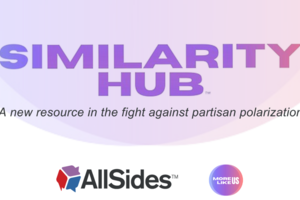Media Bias Alert: Stories About Lockdown Study, Black Lives Matter Omitted By Left and Center Media

From the Right
Each week, AllSides Media Bias Alerts examine media bias in coverage of a major or important story using AllSides Media Bias Ratings™ and the AllSides Media Bias Chart™.
Two stories that were big in media outlets rated by AllSides as having biases on the right were not covered by major left and center-rated media outlets this week.
The first story left and center outlets omitted was a study authored by a Johns Hopkins University professor and others who that found COVID-19 lockdowns in the U.S. and Europe did not significantly reduce mortality. The researchers conclude that lockdown policies "should be rejected out of hand as a pandemic policy instrument,” saying they "reduced COVID-19 mortality by 0.2% on average.” The paper notes that “the views expressed in each working paper are those of the authors and not necessarily those of the institutions that the authors are affiliated with.”
The second story not mentioned by one side of the press is the Black Lives Matter Global Network Foundation shutting down its online fundraising after both California and Washington ordered it to stop collecting donations. BLM reportedly failed to disclose information about its 2020 finances. A Washington Examiner (Lean Right) investigation “found that BLM has had no known leader in charge of its $60 million bankroll since its co-founder resigned in May.” BLM’s charity registration is also reportedly out of compliance in Connecticut, Maine, Maryland, New Jersey, North Carolina and Virginia, according to the Examiner.
Outlets On the Right Covered the Stories; Outlets on the Left and Center Did Not
At the time of this writing (Feb. 3, 3pm CT), The lockdown study was notably covered by the right and not the left or center. Outlets that covered the story were:
Fox News (Right bias), Newsmax (Lean Right), National Post (Lean Right), New York Post (Lean Right), The Daily Mail x2 (Right), Wall Street Journal Opinion (Lean Right), FEE.org (Lean Right), National Review x2, and many local outlets not rated by AllSides.
The only outlet on the left to cover it was fact check outlet Snopes (Lean Left), which focused on very different aspects of the study than right-rated outlets (more on that below).
Similarly, The Black Lives story was only covered by the following major outlets (some smaller blogs covered the story, too; they are not noted here):
Washington Examiner (Lean Right), The New York Post (Lean Right), Independent Journal Review (Lean Right), The Daily Mail (Right), Fox Business (Lean Right), National Review (Right), The Daily Wire (Right), Accuracy in Media (Right), and The Daily Caller (Right).
The only outlet on the left to cover the BLM story was Yahoo (Lean Left), which republished the piece by National Review. (Did we miss a story? Email us.)
Why These Stories Deserve Attention
Arguably, both of these stories deserve coverage due to being developments in two major storylines that have dominated the press since 2020: the COVID-19 pandemic and the Black Lives Matter movement.
People around the world were locked down inside their homes for weeks or months at the beginning of the coronavirus pandemic. One third of the world was in some kind of lockdown in April 2020, and Australia has remained one of the most locked-down countries in the world. News outlets that repeatedly referred to Johns Hopkins University’s COVID-19 Map to report case numbers — which fed support for lockdowns — have not covered the new study.
From the beginning of the COVID-19 pandemic, commentators and politicians on the right were more likely to question the use of lockdowns to control the virus, while commentators, media outlets and politicians on the left were more likely to support lockdowns. Democratic governors were quicker to issue stay-at-home orders, and governors in red states like Florida and Texas were heavily criticized for declining to re-implement lockdowns in 2021. In 2020, AllSides wrote about how the media was more likely to frame anti-lockdown protesters negatively/as contributing to viral spread, while framing racial justice protests positively. It was just another way the left/right divide manifested in the United States.

Likewise, in Summer 2020, following the death of George Floyd by police, Black Lives Matter exploded in attention, raising $90 million that year alone. The BLM movement dominated media headlines for months. Black Lives Matter supporters protested and rioted for months in cities worldwide; the movement sparked both widespread support and widespread criticism and controversy.
Perhaps most notably related to the news about BLM’s finances, corporations donated tens of millions of dollars to the group and related groups and causes. At least 18 companies donated or pledged to donate money directly to the BLM Global Network Foundation, according to a list compiled by the Washington-based Capital Research Center. Major corporations like Apple, Amazon, Home Depot, Walmart, Etsy, Wendy’s, Target, H&M, Coca-Cola, Peloton, and Ubisoft — to name only a few — signaled support for BLM in statements posted to social media, as well as made public commitments to donate.
Considering all of this backstory — only a fraction of which is recounted here for both storylines — it seems at least notable that BLM has shut down its donations and that a study has concluded lockdowns are mostly ineffective. Media outlets on both sides ought to have covered the developments.
Understanding Media Bias by Story Choice and Bias by Omission
Journalists are limited in their time, space, and resources, so they can’t possibly cover every story. Story choice is a type of media bias that can reveal the political leanings of a media outlet. That’s because story choice is always subjective in nature, as it requires editors to make a judgment call about whether or not a story is important or valuable for readers to know.
Story choice bias is closely related to media bias by omission, because noticing which stories one side chooses not to cover can also clue us in as to what the publication thinks is important or what they want to downplay.
RELATED: Media Bias Alert: Is Canada’s Freedom Convoy Righteous or Dangerous?
Outlets on the right tend to highlight ethical concerns about progressive advocacy groups such as Black Lives Matter, while the opposite: left-rated outlets tend to cover conservative groups more critically. Meanwhile, each side typically tends to ignore problems with groups that align with their political side and ideology.
With the Johns Hopkins study, several factors likely played a role in left-rated sources deciding not to report on it: it was not peer-reviewed, it was conducted by economists rather than epidemiologists, the researchers included mask mandates in its definition of lockdowns, and it didn’t fit the common mainstream narrative that lockdowns were necessary to fight COVID-19. All of these things were noted by Snopes in its analysis of the study. For their part, media outlets on the right arguably engaged in media bias by omission by not including these details, or signaled writers and editors at those outlets did not find those details to be important.
Conclusion
The omission of stories about the Johns Hopkins lockdown study and Black Lives Matter’s financial issues shows why it is so important to read news across the political spectrum and to become aware of media bias.
Only by ingesting an unbiased, balanced news diet can you be sure you are getting the full story. Use AllSides’ balanced newsfeed, Media Bias Ratings, and guide to How to Spot Types of Media Bias to get the full picture and think for yourself.
Julie Mastrine is the Director of Marketing and Media Bias Ratings at AllSides. She has a Lean Right bias.
This piece was reviewed by AllSides Managing Editor Henry A. Brechter (Center), Research Assistant & Data Journalist Andrew Weinzierl (Lean Left), and Reserach Intern Aidanne DePoy (Left).
Detect and debunk misinformation
The News Literacy Project
April 29 at 4pm PT / 7pm ET
UNUM: “Resetting the Table – Wisdom from Conflict”
USC Center for the Political Future
May 02 at 2pm PT / 5pm ET
WordsView – Aligning Words and Aligning Relationships
Mediators Beyond Borders International
May 28 at 7:30am PT / 10:30am ET

April 26th, 2024

April 25th, 2024

April 25th, 2024